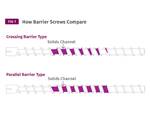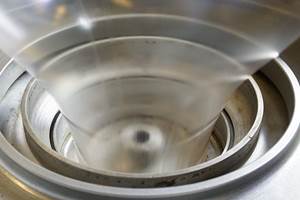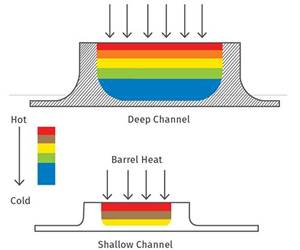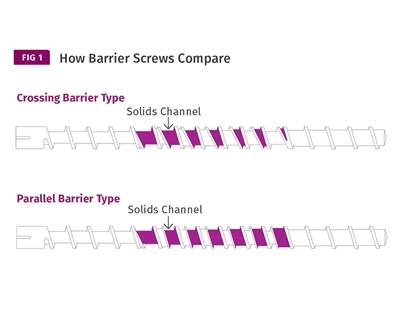Worn Feed Casings Can Reduce Your Output
While barrels typically last for the service life of three screws, when the feed casing wears it can wreak havoc on production rates.

FIG 1 Motor current and discharge pressure as a function of time.
As discussed in a June 2023 Extrusion Know-How column in this magazine, barrels and screws wear over time and can cause reduced rates and high discharge temperatures. It was explained that the screw will typically wear at a higher rate than the barrel. When the screw wear is high enough that the process becomes less economical to operate, it should be replaced. Typical economics for screw wear were presented in an April 2025 article in this magazine. A barrel will typically last for the service life of three screws.
The rate that screws and barrels wear depends on the resins extruded, the level of solids in the channel locally, the level and types of fillers in the resin, velocity (screw speed), local pressure, materials of construction and the alignment of the barrel with the gear box. The highest wear rate typically occurs at the end of the transition section where solids can get wedged at the exit of a barrier section. At this location, the pressure can also be relatively high. High wear rates can occur for both the screw and barrel.
The feed casing for smooth-bore extruders can also wear, but at a lower rate than the barrel. The lower wear rate is due to the low pressure in the feed casing. The wear rate in the casing will depend on the local pressure and the fillers in the resin. The casing is typically constructed from malleable steel. To reduce the wear rate, either the screw flights are undercut to 2-3 times the normal flight clearance, or the casing is fabricated slightly oversized. On older extruders and after a few barrel changes, the feed casing can be worn enough to reduce the rate of the extruder and cause flow surging.
As an example, a 4.5-inch diameter, smooth-bore, commercial extruder was experiencing severe and random motor amperage oscillations while operating at a reduced rate for a polystyrene (PS) resin. The screw geometry was very standard and acceptable for flood-fed, plasticating extrusion of PS. The extruder was operating at the maximum screw speed, and it was the rate-limiting step for the line. Higher rates were expected, but unattainable. The extruder was operating at a rate that was about 60% of the expected rate. That is, the specific rate was 60% of what was expected.
Specific rate is simply the rate divided by the screw speed. Both the barrel and screw were new and thus had clearance specifications that were standard for this size extruder. The motor current and discharge pressure, indicating unstable operation, are shown by Figure 1. The motor current ranged from about 120 to 200 amps, a level of variation that is abnormal for this size machine and operation. During this period, however, the line was operating with a relatively stable discharge pressure, producing prime products, although at a rate that was considerably lower than desired.

FIG 2 Schematic of a worn feed casing and a new barrel. A ledge is formed at the connection flange.
After some investigation, it was determined that the barrel had been replaced several times. The focus turned to determining the wear on the feed casing. Since the barrel was attached and aligned to the gear box, it was decided to remove the screw and look for a ledge at the connection between the barrel and feed casing. An optical scope was inserted down the hopper and into the feed casing. The scope showed that an annular ledge existed at the connection between the feed casing and the new barrel. The ledge was about 2.5-mm wide. Thus, the feed casing was worn by about 5 mm in diameter, creating a cylinder that was larger than the inside diameter of the new barrel.
It was not known if the wear was uniform in the axial direction. A schematic of the ledge is provided by Figure 2. This worn casing also caused the clearance between the flight lands and the casing to be 2.6 mm a clearance that was about 25 times higher than normal. This clearance was about the size of a PS pellet. Thus, pellets had the ability to flow over the flight tip although this was likely only a minor issue.
The ledge was large enough to interrupt the forwarding of the pellets, causing a restriction on the flow of solids from the feed casing to the barrel. When the restriction was the highest, the extruder would operate with a lower level of fill, causing the motor current to decrease quickly, as shown in Figure 1. When pellets started to flow at a higher rate, the motor current returned to the baseline level. As previously discussed, the extruder was operating at 60% of the expected rate. The line was unable to keep up with product demand.
When the new barrel is installed, it should always be aligned with the gear box.
Building a new feed casing and getting it installed was going to take more time than the plant personnel could tolerate. After a considerable level of research and testing, the plan was to remove the ledge by creating a taper in the first portion of the barrel, as shown by Figure 3. The taper will allow the flow of pellets to be unrestricted.

FIG 3 Schematic of a temporary fix to remove the ledge formed by a worn feed casing and a new barrel.
The barrel was removed from the extruder, and the diameter of the barrel entry was ground to the diameter of the feed casing. The taper went into the barrel about 0.5 inch where the barrel was the factory diameter. The modified barrel was placed back on the extruder and was aligned with the gear box. This configuration did not have a ledge that could restrict the flow of pellets.
The extruder was started back up with the modified barrel, and the extruder was returned to its original performance. That is, the rate was restored to 100% and the motor current was not surging. The modified barrel removed the ledge and the restriction at the connection between the feed casing the barrel, and it allowed time to have a new feed casing built.
Since screws, barrels, and feed casings wear at different rates, it is important to measure these components periodically. Moreover, every time a barrel is replaced, the wear level should be assessed on the feed casing with the barrel removed. When the new barrel is installed, it should always be aligned with the gear box. Out-of-alignment barrels can cause high levels of wear to occur, decreasing the service life of the components.
About the Author: Mark A. Spalding is a fellow in Packaging & Specialty Plastics and Hydrocarbons R&D at Dow Inc. in Midland, Michigan. During his 40 years at Dow, he has focused on development, design and troubleshooting of polymer processes, especially in single-screw extrusion. He co-authored with Gregory Campbell. Contact: 989-636-9849; maspalding@dow.com; .
Related Content
Reduce Downtime and Scrap in the Blown Film Industry
The blown film sector now benefits from a tailored solution developed by Chem-Trend to preserve integrity of the bubble.
Read MoreHow to Select the Right Cooling Stack for Sheet
First, remember there is no universal cooling-roll stack. And be sure to take into account the specific heat of the polymer you are processing.
Read MoreHow To Identify Resin Degradation in Single-Screw Extruders
Degradation can occur in many single-screw extrusion operations, and typically occurs due to minor design flaws in the screw. Here is how to track it down.
Read MoreThe Importance of Barrel Heat and Melt Temperature
Barrel temperature may impact melting in the case of very small extruders running very slowly. Otherwise, melting is mainly the result of shear heating of the polymer.
Read MoreRead Next
Barrier Screws: Not All Are Created Equal
Let’s take a deep dive into parallel and crossing types and see where each fit in.
Read MoreIn Single Screw Extruders, Mixing Starts in the Melting Process
While the melting process does not provide perfect mixing, this study shows that mixing is indeed initiated during melting.
Read More










